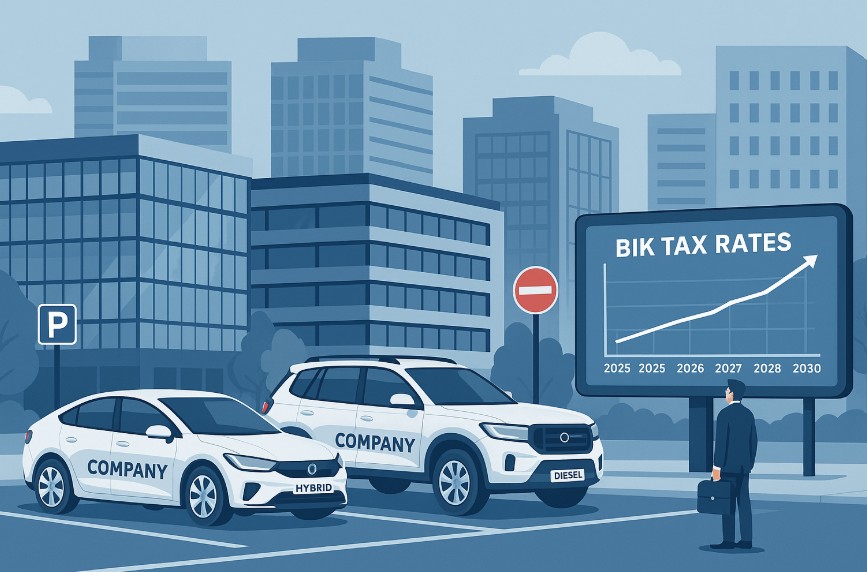Table of Contents
ToggleFrom 6 April 2025, sweeping changes to BIK tax rates introduced by Chancellor Rachel Reeves have officially come into force marking a turning point for employers, company car users, and the wider business community. Affecting over 760,000 company car drivers across the UK, these changes significantly reshape the landscape of vehicle taxation and employee benefits.
The revised BIK framework includes gradual increases in electric vehicle tax rates, steep hikes for hybrids and high-emission cars, and a controversial reclassification of double cab pickups. While these reforms aim to promote greener transport, they also introduce new financial pressures that businesses cannot afford to ignore.
In this guide, we break down exactly what’s changing, who it impacts, and how UK organisations can respond strategically to minimise costs and maintain compliance.
What Is Benefit-in-Kind (BIK) Tax?

Benefit-in-Kind (BIK) tax applies when employees receive perks that aren’t part of their direct salary such as company cars, accommodation, or private medical insurance. These perks, while valuable, are considered taxable income by HMRC and must be declared by both the employer and employee.
In the case of company vehicles, BIK is calculated using several factors:
- Vehicle list price (P11D value)
- CO₂ emissions
- Fuel type (petrol, diesel, electric, hybrid)
- Registration date of the car
This tax has long been a consideration for businesses offering vehicles as part of an employee compensation package. In many cases, company cars represent both a practical and attractive benefit, especially in roles involving frequent travel.
Why Does BIK Tax Matter to UK Businesses in 2025?
The relevance of BIK tax has increased sharply in 2025 due to recent changes announced by Labour’s Shadow Chancellor, Rachel Reeves. These updates are not just routine tax adjustments, they represent a rethinking of how businesses and individuals are incentivised to transition toward greener vehicles.
UK businesses, particularly SMEs and startups, often rely on company cars to retain talent and manage logistics. With new BIK rates now in force, the cost of offering these perks has changed dramatically. Companies that fail to understand and plan for these updates risk higher operational expenses and potential non-compliance.
The reforms are expected to affect an estimated 760,000 employees who currently use company cars across the UK.
What Is Rachel Reeves Proposing in Her BIK Tax Reform Plan?

Rachel Reeves has introduced a strategic tax policy focused on incentivising sustainable choices while increasing fiscal responsibility. The updated BIK tax rates, effective from 6 April 2025, are designed to gradually increase tax on high-emission vehicles, while offering prolonged benefits to drivers of electric vehicles.
As Chancellor, Reeves’ plan includes:
- A gradual increase in BIK tax rates for electric vehicles (EVs), designed to be predictable and manageable.
- Significant hikes in BIK rates for petrol, diesel, and plug-in hybrids, particularly those with limited electric range.
- A new classification system for double cab pickups, previously treated as vans, which now face much higher tax rates under the BIK structure.
The overarching aim is to reshape corporate fleet behaviour while maintaining a long-term incentive for low-emission choices.
What Are the Key BIK Tax Changes from April 2025?
The government has introduced a five-year roadmap for BIK tax changes:
BIK Increases for Electric Vehicles
Electric vehicles, which previously enjoyed a 2% BIK rate, will now follow an upward trajectory:
- 2025/26: 3%
- 2026/27: 4%
- 2027/28: 5%
- 2028/29: 7%
- 2029/30: 9%
While this represents a rise, EVs still remain considerably more tax-efficient than petrol or diesel vehicles, especially when paired with salary sacrifice schemes.
Hybrid Vehicle Tax Hikes
Plug-in hybrids, which emit between 1–50g/km of CO₂, will face steeper increases:
- 2028/29: 18%
- 2029/30: 19%
Previously, these vehicles enjoyed rates between 5% and 17%, based on electric range. These reforms signal a narrowing of incentives to prioritise full electric vehicles over hybrids.
Increases for Petrol, Diesel, and High Emission Vehicles
Vehicles with emissions between 51–54g/km will see BIK rates rise to:
- 19% in 2028/29
- 20% in 2029/30
For high-emission vehicles (160g/km and above), the rate will climb:
- From 37% currently to 38% in 2028/29
- Then 39% in 2029/30
Diesel vehicles not meeting the latest emission standards will continue to face a 4% surcharge on top of these rates.
How Will These BIK Changes Affect Company Vehicle Costs?
For many employers, these changes mean a substantial cost increase, particularly for fleets made up of diesel or hybrid models. Employees will also notice higher personal tax bills on company vehicles, which could reduce the attractiveness of such benefits.
In particular:
- Businesses offering double cab pickups could face tax increases of up to £15,000 per vehicle per year.
- National Insurance contributions on high-BIK vehicles will also increase employer liabilities.
- Companies may need to adjust salary packages to accommodate for higher BIK rates.
What Does the Reclassification of Double Cab Pickups Mean?

Double Cabs Reclassified from April 2025
Double cab pickups, commonly used in construction, agriculture, and trades, have long been treated as vans for tax purposes. This classification allowed them to benefit from lower fixed-rate BIK charges. However, from April 2025, this treatment will no longer apply.
HMRC has confirmed that:
- The classification will now depend on a two-part suitability test, assessing whether the vehicle is primarily constructed for goods transport.
- Vehicles failing this test will be taxed like cars under BIK rules, with emissions-based charges.
Cost Implications for Employers
Under the new BIK structure:
- High-emission diesel pickups will fall under a sliding BIK scale.
- Businesses could face up to £15,000 in extra taxes per vehicle per year.
- This change could force companies to rethink fleet choices, particularly in sectors relying on pickups for daily operations.
However, transitional relief will apply. Vehicles ordered or leased before April 2025 will continue under existing tax treatment until the earlier of disposal, lease expiry, or April 5, 2029.
How Will Company Car Taxation Be Structured Going Forward?
| Vehicle Type | 2024 BIK Rate | 2025/26 | 2026/27 | 2027/28 | 2028/29 | 2029/30 |
| Electric Vehicles (EVs) | 2% | 3% | 4% | 5% | 7% | 9% |
| Hybrids (1-50g/km CO₂) | 5–17% | Same | Same | Same | 18% | 19% |
| Petrol/Diesel (51-54g/km) | ~25% | Same | Same | Same | 19% | 20% |
| High Emission (160g/km+) | 37% | 37% | 37% | 37% | 38% | 39% |
How Should UK Businesses Prepare for the New BIK Tax Landscape?
Step 1: Audit Your Current Fleet

Start by evaluating the BIK classification of all company vehicles. Focus on:
- Emissions ratings
- Fuel type
- Purchase/lease dates
Step 2: Transition to Electric or Lower Emission Vehicles

Given the preferential tax treatment for EVs, moving your fleet in this direction makes both fiscal and environmental sense.
Step 3: Adjust Salary Sacrifice Schemes

Educate employees on how salary sacrifice schemes can still offer savings, particularly when tied to EVs with low BIK rates.
Step 4: Explore Alternative Transport Solutions

Some businesses may find it more efficient to:
- Switch to traditional vans for goods transport
- Use public transport subsidies for urban roles
- Offer cash alternatives to vehicle perks
What Are the Broader Industry Implications of Rachel Reeves’ BIK Reforms?
A Shift in Employer Priorities
As costs rise, employers may reduce reliance on vehicle-based benefits or switch to more sustainable mobility packages. This could spur growth in EV lease providers, fleet-as-a-service models, and mobility-as-a-benefit schemes.
Impact on Trade and Agriculture
Industries dependent on double cab pickups may face serious cost increases. Bumper, a leading tax advisory firm, suggests this change could be a “significant hit for tradespeople” and rural businesses.
Tax Incentives Become More Focused
Rachel Reeves’ policy clearly distinguishes between full EVs and all other vehicle types. This shift suggests that hybrid technology may no longer benefit from government backing, and long-term planning should favour full electrification.
What Should Businesses Do Right Now to Mitigate the Impact?
- Review fleet policies immediately
- Replace pending vehicle orders with electric alternatives
- Leverage the transition rule for vehicles ordered before April 2025
- Communicate policy changes to HR and finance teams
- Seek tailored tax advice for complex vehicle use-cases
Being proactive will allow businesses to maintain compliance, reduce costs, and improve sustainability metrics.
Also Read: Older Drivers Car Tax Changes in 2025: Who Pays More and Why?
Conclusion
The Rachel Reeves BIK tax changes signal a bold shift in the UK’s approach to business vehicle taxation one that prioritises environmental sustainability, fiscal clarity, and behavioural change. For many employers, the days of low flat-rate company car taxes are over, replaced with a more complex but targeted emissions-based model.
Whether you’re managing a growing startup or leading a nationwide fleet, the 2025 reforms require swift evaluation and action. From reassessing vehicle choices to leveraging salary sacrifice schemes and monitoring HMRC updates, proactive planning will be key to adapting without disruption.
By embracing the move toward electric and low-emission vehicles and understanding the tax implications of every fleet decision, UK businesses can stay ahead of the curve, avoid costly penalties, and continue offering valuable employee benefits in an evolving landscape.
FAQs About Rachel Reeves BIK Tax Changes
What is the most significant change introduced in April 2025?
The reclassification of double cab pickups and the incremental rise in BIK for EVs and hybrids are the most notable changes under Rachel Reeves’ reform.
Can businesses still order vehicles under the old tax rules?
Yes. Any company car or double cab pickup ordered before April 2025 will retain the previous tax treatment until April 2029 or lease termination.
Will electric vehicles still be cheaper in the long run?
Despite gradual increases in BIK, EVs remain the most tax-efficient option and benefit from lower running costs.
How can employers reduce BIK tax exposure?
Transitioning to electric fleets, using salary sacrifice schemes, and offering alternative benefits can help mitigate tax burdens.
Is HMRC guidance already available?
Initial guidance is live, with more expected throughout 2025 as the new policy beds in. Businesses are encouraged to monitor gov.uk for updates.
How much could a diesel pickup cost in extra tax per year?
Some high-emission models could face up to £15,000 annually in BIK tax, especially if they no longer qualify as vans.
Will hybrid incentives disappear completely?
While not eliminated, hybrids will receive fewer tax advantages by 2029 compared to fully electric vehicles.




